Research Progress on Blue-Phase Liquid Crystals for Pattern Replication Applications
Abstract
:1. Introduction
2. Patterned Applications of Blue Phase Liquid Crystals
2.1. Application of Blue-Phase Spontaneous Micropattern
2.2. Electrically Responsive Blue-Phase Patterned Mode–BPLCD
2.3. Blue-Phase Patterned Mode Based on Handwriting
2.4. Mask-Based Optical Writing of Blue-Phase Patterned mode
2.5. Maskless Inkjet Printing of Blue-Phase Patterned Mode
2.5.1. Humidity Responsive Inkjet Printing Blue-Phase Patterned Mode
2.5.2. Solvent-Responsive Inkjet Printing of Blue-Phase Patterned Mode
3. Conclusions and Outlook
Author Contributions
Funding
Institutional Review Board Statement
Informed Consent Statement
Data Availability Statement
Conflicts of Interest
Sample Availability
References
- Kikuchi, H.; Yokota, M.; Hisakado, Y.; Yang, H.; Kajiyama, T. Polymer-stabilized liquid crystal blue phases. Nat. Mater. 2002, 1, 64–68. [Google Scholar] [CrossRef] [PubMed]
- Hu, W.; Wang, L.; Wang, M.; Zhong, T.; Wang, Q.; Zhang, L.; Chen, F.; Li, K.; Miao, Z.; Yang, D.; et al. Ultrastable liquid crystalline blue phase from molecular synergistic self-assembly. Nat. Commun. 2021, 12, 1440. [Google Scholar] [CrossRef] [PubMed]
- Chen, C.W.; Hou, C.T.; Li, C.C.; Jau, H.C.; Wang, C.T.; Hong, C.L.; Guo, D.Y.; Wang, C.Y.; Chiang, S.P.; Bunning, T.J.; et al. Large three-dimensional photonic crystals based on monocrystalline liquid crystal blue phases. Nat. Commun. 2017, 8, 727. [Google Scholar] [CrossRef] [PubMed] [Green Version]
- Reinitzer, F. Beiträge zur Kenntniss des Cholesterins. Mon. Für Chem. Und Verwandte Teile And. Wiss. 1888, 9, 421–441. [Google Scholar] [CrossRef]
- Coles, H.J.; Pivnenko, M.N. Liquid crystal ‘blue phases’ with a wide temperature range. Nature 2005, 436, 997–1000. [Google Scholar] [CrossRef]
- He, W.; Pan, G.; Yang, Z.; Zhao, D.; Niu, G.; Huang, W.; Yuan, X.; Guo, J.; Cao, H.; Yang, H. Wide Blue Phase Range in a Hydrogen-Bonded Self-Assembled Complex of Chiral Fluoro-Substituted Benzoic Acid and Pyridine Derivative. Adv. Mater. 2009, 21, 2050–2053. [Google Scholar] [CrossRef]
- Karatairi, E.; Rozic, B.; Kutnjak, Z.; Tzitzios, V.; Nounesis, G.; Cordoyiannis, G.; Thoen, J.; Glorieux, C.; Kralj, S. Nanoparticle-induced widening of the temperature range of liquid-crystalline blue phases. Phys. Rev. E Stat Nonlin. Soft Matter. Phys. 2010, 81, 041703. [Google Scholar] [CrossRef] [Green Version]
- Shi, Y.; Wang, X.; Wei, J.; Yang, H.; Guo, J. Stabilization of blue phases by hydrogen-bonded bent-shaped and T-shaped molecules featuring a branched terminal group. Soft Matter. 2013, 9, 10186–10195. [Google Scholar] [CrossRef]
- Yamamoto, J.; Nishiyama, I.; Inoue, M.; Yokoyama, H. Optical isotropy and iridescence in a smectic ‘blue phase’. Nature 2005, 437, 525–528. [Google Scholar] [CrossRef]
- Yu, Y.-B.; He, W.-L.; Jiang, Z.-M.; Yu, Z.-F.; Ren, L.; Lu, Y.; Yang, Z.; Cao, H.; Wang, D. The effects of azo-oxadiazole-based bent-shaped molecules on the temperature range and the light-responsive performance of blue phase liquid crystal. Liq. Cryst. 2019, 46, 1024–1034. [Google Scholar] [CrossRef]
- Dierking, I.; Blenkhorn, W.; Credland, E.; Drake, W.; Kociuruba, R.; Kayser, B.; Michael, T. Stabilising liquid crystalline Blue Phases. Soft Matter. 2012, 8, 4355–4362. [Google Scholar] [CrossRef]
- Tian, L.-L.; Chu, F.; Duan, W.; Li, R.; Gu, X.-Q.; Li, L.; Wang, Q.-H. Beam steering device based on blue phase liquid crystal. Opt. Commun. 2021, 481, 126525. [Google Scholar] [CrossRef]
- Xiang, J.; Lavrentovich, O.D. Blue-phase-polymer-templated nematic with sub-millisecond broad-temperature range electro-optic switching. Appl. Phys. Lett. 2013, 103, 051112. [Google Scholar] [CrossRef] [Green Version]
- Chen, Y.; Wu, S.-T. Recent advances on polymer-stabilized blue phase liquid crystal materials and devices. J. Appl. Polym. Sci. 2014, 131, 1–7. [Google Scholar] [CrossRef]
- Seishi Shibayama, H.H.; Okumura, Y.; Kikuchi, H. Dendron-Stabilized Liquid Crystalline Blue Phases with an Enlarged Controllable Range of the Photonic Band for Tunable Photonic Devices. Adv. Funct. Mater. 2012, 23, 2387–2396. [Google Scholar] [CrossRef]
- Oton, E.; Yoshida, H.; Morawiak, P.; Strzezysz, O.; Kula, P.; Ozaki, M.; Piecek, W. Orientation control of ideal blue phase photonic crystals. Sci. Rep. 2020, 10, 10148. [Google Scholar] [CrossRef]
- Oton, E.; Morawiak, P.; Galadyk, K.; Oton, J.M.; Piecek, W. Fast self-assembly of macroscopic blue phase 3D photonic crystals. Opt. Express 2020, 28, 18202–18211. [Google Scholar] [CrossRef]
- Chen, Y.; Zheng, C.; Yang, W.; Li, J.; Jin, F.; Li, X.; Wang, J.; Jiang, L. Over 200 degrees C Broad-Temperature Lasers Reconstructed from a Blue-Phase Polymer Scaffold. Adv. Mater. 2022, 34, e2206580. [Google Scholar] [CrossRef]
- Cao, W.; Munoz, A.; Palffy-Muhoray, P.; Taheri, B. Lasing in a three-dimensional photonic crystal of the liquid crystal blue phase II. Nat. Mater. 2002, 1, 111–113. [Google Scholar] [CrossRef]
- Hur, S.T.; Lee, B.R.; Gim, M.J.; Park, K.W.; Song, M.H.; Choi, S.W. Liquid-crystalline blue phase laser with widely tunable wavelength. Adv. Mater. 2013, 25, 3002–3006. [Google Scholar] [CrossRef]
- Hou, J.; Li, M.; Song, Y. Patterned Colloidal Photonic Crystals. Angew. Chem. Int. Ed. Engl. 2018, 57, 2544–2553. [Google Scholar] [CrossRef] [PubMed]
- Chen, K.; Fu, Q.; Ye, S.; Ge, J. Multicolor Printing Using Electric-Field-Responsive and Photocurable Photonic Crystals. Adv. Funct. Mater. 2017, 27, 1702825. [Google Scholar] [CrossRef]
- Shang, L.; Zhang, W.; Xu, K.; Zhao, Y. Bio-inspired intelligent structural color materials. Mater. Horiz. 2019, 6, 945–958. [Google Scholar] [CrossRef]
- Wang, Y.; Shang, L.; Chen, G. Bioinspired structural color patch with anisotropic surface adhesion. Sci. Adv. 2020, 6, eaax8258. [Google Scholar] [CrossRef] [PubMed] [Green Version]
- Yang, Y.; Chen, Y.; Hou, Z.; Li, F.; Xu, M.; Liu, Y.; Tian, D.; Zhang, L.; Xu, J.; Zhu, J. Responsive Photonic Crystal Microcapsules of Block Copolymers with Enhanced Monochromaticity. ACS Nano 2020, 14, 16057–16064. [Google Scholar] [CrossRef]
- Ding, T.; Luo, L.; Wang, H.; Chen, L.; Liang, K.; Clays, K.; Song, K.; Yang, G.; Tung, C.-H. Patterning and pixelation of colloidal photonic crystals for addressable integrated photonics. J. Mater. Chem. 2011, 21, 11330. [Google Scholar] [CrossRef]
- Hong, W.; Yuan, Z.; Chen, X. Structural Color Materials for Optical Anticounterfeiting. Small 2020, 16, e1907626. [Google Scholar] [CrossRef]
- Chen, G.; Zhang, K.; Luo, B.; Hong, W.; Chen, J.; Chen, X. Plasmonic-3D photonic crystals microchip for surface enhanced Raman spectroscopy. Biosens. Bioelectron. 2019, 143, 111596. [Google Scholar] [CrossRef]
- Zheng, Z.G.; Li, Y.; Bisoyi, H.K.; Wang, L.; Bunning, T.J.; Li, Q. Three-dimensional control of the helical axis of a chiral nematic liquid crystal by light. Nature 2016, 531, 352–356. [Google Scholar] [CrossRef]
- Fan, J.; Li, Y.; Bisoyi, H.K.; Zola, R.S.; Yang, D.K.; Bunning, T.J.; Weitz, D.A.; Li, Q. Light-directing omnidirectional circularly polarized reflection from liquid-crystal droplets. Angew. Chem. Int. Ed. Engl. 2015, 54, 2160–2164. [Google Scholar] [CrossRef]
- Ma, J.; Li, Y.; White, T.; Urbas, A.; Li, Q. Light-driven nanoscale chiral molecular switch: Reversible dynamic full range color phototuning. Chem. Commun. 2010, 46, 3463–3465. [Google Scholar] [CrossRef] [PubMed]
- Venkataraman, N.; Khan, A.; Shiyanovskaya, I.; Schneider, T.; Doane, J.W.; Green, L.; Li, Q. Novel optically addressable photochiral displays Erica Montbach. SID Dig. Tech. Pap. 2008, 39, 919–922. [Google Scholar] [CrossRef]
- Mulder, D.J.; Schenning, A.P.H.J.; Bastiaansen, C.W.M. Chiral-nematic liquid crystals as one dimensional photonic materials in optical sensors. J. Mater. Chem. C 2014, 2, 6695–6705. [Google Scholar] [CrossRef] [Green Version]
- Zheng, J.; He, Z.; Li, C.; Miao, Z.; Wang, D.; Luan, Y.; Li, Y.; Zhao, Y.; Cao, H.; He, W.; et al. Reflectance-enhanced liquid crystal displays and thermochromic multi-color patterning. Dye. Pigment. 2022, 205, 110598. [Google Scholar] [CrossRef]
- Li, Q.; Li, Y.; Ma, J.; Yang, D.K.; White, T.J.; Bunning, T.J. Directing dynamic control of red, green, and blue reflection enabled by a light-driven self-organized helical superstructure. Adv. Mater. 2011, 23, 5069–5073. [Google Scholar] [CrossRef]
- Zhang, L.; Cui, Y.; Wang, Q.; Zhou, H.; Wang, H.; Li, Y.; Yang, Z.; Cao, H.; Wang, D.; He, W. Spatial Patterning of Fluorescent Liquid Crystal Ink Based on Inkjet Printing. Molecules 2022, 27, 5536. [Google Scholar] [CrossRef]
- Comiskey, B.; Albert, J.D.; Yoshizawa, H.; Jacobson, J. An electrophoretic ink for all-printed reflective electronic displays. Nature 1998, 394, 253–255. [Google Scholar] [CrossRef]
- Schadt, M. Liquid crystal materials and liquid crystal displays. Annu. Rev. Mater. Sci. 1997, 27, 305–379. [Google Scholar] [CrossRef] [Green Version]
- Yeh, P. Optics of Liquid Crystal Displays. In Proceedings of the 2007 Conference on Lasers and Electro-Optics—Pacific Rim, Seoul, Korea, 26–31 August 2007. [Google Scholar]
- Uchida, T.; Ishinabe, T. Reflective Liquid Crystal Displays. MRS Bull. 2002, 27, 876–879. [Google Scholar] [CrossRef]
- Petkoska, A.T. Polymer Choleristic Liquid Crystal Flakes as New Candidates for Display and Sensor Applications. In Nanotechnological Basis for Advanced Sensors; NATO Science for Peace and Security Series B: Physics and Biophysics; Springer: Berlin/Heidelberg, Germany, 2011; pp. 315–322. [Google Scholar]
- Trajkovska-Petkoska, A.; Varshneya, R.; Kosc, T.Z.; Marshall, K.L.; Jacobs, S.D. Enhanced Electro-Optic Behavior for Shaped Polymer Cholesteric Liquid-Crystal Flakes Made Using Soft Lithography. Adv. Funct. Mater. 2005, 15, 217–222. [Google Scholar] [CrossRef]
- Marshall, K.L.; Hasman, K.; Leitch, M.; Cox, G.; Kosc, T.Z.; Trajkovska-Petkoska, A.; Jacobs, S.D. 62.3: Doped Multilayer Polymer Cholesteric-Liquid-Crystal (PCLC) Flakes: A Novel Electro-Optical Medium for Highly Reflective Color Flexible Displays. SID Symp. Dig. Tech. Pap. 2007, 38, 1741–1744. [Google Scholar] [CrossRef]
- Yadav, S.P.; Singh, S. Carbon nanotube dispersion in nematic liquid crystals: An overview. Prog. Mater. Sci. 2016, 80, 38–76. [Google Scholar] [CrossRef]
- Singh, G.; Fisch, M.; Kumar, S. Emissivity and electrooptical properties of semiconducting quantum dots/rods and liquid crystal composites: A review. Rep. Prog. Phys. 2016, 79, 056502. [Google Scholar] [CrossRef]
- Supreet; Singh, G. Recent advances on cadmium free quantum dots-liquid crystal nanocomposites. Appl. Mater. Today 2020, 21, 100840. [Google Scholar] [CrossRef]
- Kumar, A.; Pratap Singh, D.; Singh, G. Recent progress and future perspectives on carbon-nanomaterial-dispersed liquid crystal composites. J. Phys. D: Appl. Phys. 2021, 55, 083002. [Google Scholar] [CrossRef]
- Wang, L.; Bisoyi, H.K.; Zheng, Z.; Gutierrez-Cuevas, K.G.; Singh, G.; Kumar, S.; Bunning, T.J.; Li, Q. Stimuli-directed self-organized chiral superstructures for adaptive windows enabled by mesogen-functionalized graphene. Mater. Today 2017, 20, 230–237. [Google Scholar] [CrossRef]
- Liu, Y.; Lan, Y.-f.; Zhang, H.; Zhu, R.; Xu, D.; Tsai, C.-Y.; Lu, J.-K.; Sugiura, N.; Lin, Y.-C.; Wu, S.-T. Optical rotatory power of polymer-stabilized blue phase liquid crystals. Appl. Phys. Lett. 2013, 102, 131102. [Google Scholar] [CrossRef] [Green Version]
- Rao, L.; Wu, S.-T. Emerging blue-phase LCDs. SPIE Newsroom 2010, 7775, 3093. [Google Scholar] [CrossRef]
- Chen, K.-M.; Gauza, S.; Xianyu, H.; Wu, S.-T. Submillisecond Gray-Level Response Time of a Polymer-Stabilized Blue-Phase Liquid Crystal. J. Disp. Technol. 2010, 6, 49–51. [Google Scholar] [CrossRef]
- Meiboom, S.; Sammon, M.; Brinkman, W.F. Lattice of disclinations: The structure of the blue phases of cholesteric liquid crystals. Phys. Rev. A 1983, 27, 438–454. [Google Scholar] [CrossRef]
- Meiboom, S.; Sethna, J.P.; Anderson, P.W.; Brinkman, W.F. Theory of the Blue Phase of Cholesteric Liquid Crystals. Phys. Rev. Lett. 1981, 46, 1216–1219. [Google Scholar] [CrossRef]
- Kim, D.-Y.; Lee, S.-A.; Park, M.; Choi, Y.-J.; Yoon, W.-J.; Kim, J.S.; Yu, Y.-T.; Jeong, K.-U. Remote-Controllable Molecular Knob in the Mesomorphic Helical Superstructures. Adv. Funct. Mater. 2016, 26, 4242–4251. [Google Scholar] [CrossRef]
- Sridurai, V.; Mathews, M.; Yelamaggad, C.V.; Nair, G.G. Electrically Tunable Soft Photonic Gel Formed by Blue Phase Liquid Crystal for Switchable Color-Reflecting Mirror. ACS Appl. Mater. Interfaces 2017, 9, 39569–39575. [Google Scholar] [CrossRef] [PubMed]
- Wang, M.; Hu, W.; Wang, L.; Guo, D.-Y.; Lin, T.-H.; Zhang, L.; Yang, H. Reversible light-directed self-organized 3D liquid crystalline photonic nanostructures doped with azobenzene-functionalized bent-shaped molecules. J. Mater. Chem. C 2018, 6, 7740–7744. [Google Scholar] [CrossRef]
- Castles, F.; Morris, S.M.; Terentjev, E.M.; Coles, H.J. Thermodynamically stable blue phases. Phys. Rev. Lett. 2010, 104, 157801. [Google Scholar] [CrossRef]
- Wright, D.C.; Mermin, N.D. Crystalline liquids: The blue phases. Rev. Mod. Phys. 1989, 61, 385–432. [Google Scholar] [CrossRef]
- Kikuchi, H. Liquid Crystalline Blue Phases. In Liquid Crystalline Functional Assemblies and Their Supramolecular Structures; Structure and Bonding; Springer: Berlin/Heidelberg, Germany, 2008; pp. 99–117. [Google Scholar]
- Yang, J.; Liu, J.; Guan, B.; He, W.; Yang, Z.; Wang, J.; Ikeda, T.; Jiang, L. Fabrication and photonic applications of large-domain blue phase films. J. Mater. Chem. C 2019, 7, 9460–9466. [Google Scholar] [CrossRef]
- Jau, H.-C.; Lin, Y.-T.; Li, C.-C.; Chen, C.-W.; Lin, T.-H. Optically rewritable dynamic phase grating based on blue-phase-templated azobenzene liquid crystal. Opt. Express 2019, 27, 10580–10585. [Google Scholar] [CrossRef]
- Liu, J.; Liu, W.; Guan, B.; Wang, B.; Shi, L.; Jin, F.; Zheng, Z.; Wang, J.; Ikeda, T.; Jiang, L. Diffusionless transformation of soft cubic superstructure from amorphous to simple cubic and body-centered cubic phases. Nat. Commun. 2021, 12, 3477. [Google Scholar] [CrossRef]
- Lee, H.; Park, H.J.; Kwon, O.J.; Yun, S.J. Invited Paper:the World's First Blue Phase Liquid Crystal Display. SID Symp. Dig. Tech. Pap. 2011, 42, 121–124. [Google Scholar] [CrossRef]
- Kim, M.; Kim, M.S.; Kang, B.G.; Kim, M.-K.; Yoon, S.; Lee, S.H.; Ge, Z.; Rao, L.; Gauza, S.; Wu, S.-T. Wall-shaped electrodes for reducing the operation voltage of polymer-stabilized blue phase liquid crystal displays. J. Phys. D: Appl. Phys. 2009, 42, 235502. [Google Scholar] [CrossRef] [Green Version]
- Lan, Y.-F.; Tsai, C.-Y.; Wang, L.-Y.; Ku, P.-J.; Huang, T.-H.; Liu, C.-Y.; Sugiura, N. Identification of polymer stabilized blue-phase liquid crystal display by chromaticity diagram. Appl. Phys. Lett. 2012, 100, 171902. [Google Scholar] [CrossRef] [Green Version]
- Rao, L.; Cheng, H.-C.; Wu, S.-T. Low Voltage Blue-Phase LCDs With Double-Penetrating Fringe Fields. J. Disp. Technol. 2010, 6, 287–289. [Google Scholar] [CrossRef]
- Rao, L.; Ge, Z.; Wu, S.-T.; Lee, S.H. Low voltage blue-phase liquid crystal displays. Appl. Phys. Lett. 2009, 95, 231101. [Google Scholar] [CrossRef] [Green Version]
- Cheng, H.-C.; Yan, J.; Ishinabe, T.; Lin, C.-H.; Liu, K.-H.; Wu, S.-T. Wide-View Vertical Field Switching Blue-Phase LCD. J. Disp. Technol. 2012, 8, 627–633. [Google Scholar] [CrossRef]
- Cheng, H.-C.; Yan, J.; Ishinabe, T.; Wu, S.-T. Vertical field switching for blue-phase liquid crystal devices. Appl. Phys. Lett. 2011, 98, 261102. [Google Scholar] [CrossRef] [Green Version]
- Yan, J.; Wu, S.-T.; Cheng, K.-L.; Shiu, J.-W. A full-color reflective display using polymer-stabilized blue phase liquid crystal. Appl. Phys. Lett. 2013, 102, 081102. [Google Scholar] [CrossRef] [Green Version]
- Xu, X.W.; Zhang, X.W.; Luo, D.; Dai, H.T. Low voltage polymer-stabilized blue phase liquid crystal reflective display by doping ferroelectric nanoparticles. Opt. Express 2015, 23, 32267–32273. [Google Scholar] [CrossRef]
- Xu, X.; Liu, Z.; Liu, Y.; Zhang, X.; Zheng, Z.; Luo, D.; Sun, X. Electrically Switchable, Hyper-Reflective Blue Phase Liquid Crystals Films. Adv. Opt. Mater. 2018, 6, 1700891. [Google Scholar] [CrossRef]
- Lu, S.Y.; Chen, L.C. Electrically switched color with polymer-stabilized blue-phase liquid crystals. Opt. Lett. 2010, 35, 562–564. [Google Scholar] [CrossRef]
- Lu, S.-Y.; Chien, L.-C. A polymer-stabilized single-layer color cholesteric liquid crystal display with anisotropic reflection. Appl. Phys. Lett. 2007, 91, 131119. [Google Scholar] [CrossRef] [Green Version]
- Chen, C.-W.; Li, C.-C.; Jau, H.-C.; Yu, L.-C.; Hong, C.-L.; Guo, D.-Y.; Wang, C.-T.; Lin, T.-H. Electric Field-Driven Shifting and Expansion of Photonic Band Gaps in 3D Liquid Photonic Crystals. ACS Photonics 2015, 2, 1524–1531. [Google Scholar] [CrossRef]
- Fudouzi, H.; Xia, Y. Photonic Papers and Inks: Color Writing with Colorless Materials. Adv. Mater. 2003, 15, 892–896. [Google Scholar] [CrossRef]
- Ge, J.; Goebl, J.; He, L.; Lu, Z.; Yin, Y. Rewritable Photonic Paper with Hygroscopic Salt Solution as Ink. Adv. Mater. 2009, 21, 4259–4264. [Google Scholar] [CrossRef]
- Chen, R.; Feng, D.; Chen, G.; Chen, X.; Hong, W. Re-Printable Chiral Photonic Paper with Invisible Patterns and Tunable Wettability. Adv. Funct. Mater. 2021, 31, 2009916. [Google Scholar] [CrossRef]
- He, W.-L.; Yu, M.-D.; Pang, Y.-J.; Ren, H.; Ma, J.-L.; Shi, C.; Wang, D.; Cao, H.; Yang, Z. Nanoparticle-doped chiral nematic liquid-crystal composite and its effect in magnetic-response and electric-response flexible display. Liq. Cryst. 2018, 46, 249–256. [Google Scholar] [CrossRef]
- Wang, L.; Gutierrez-Cuevas, K.G.; Bisoyi, H.K.; Xiang, J.; Singh, G.; Zola, R.S.; Kumar, S.; Lavrentovich, O.D.; Urbas, A.; Li, Q. NIR light-directing self-organized 3D photonic superstructures loaded with anisotropic plasmonic hybrid nanorods. Chem. Commun. 2015, 51, 15039–15042. [Google Scholar] [CrossRef]
- Qi, H.; Hegmann, T. Impact of nanoscale particles and carbon nanotubes on current and future generations of liquid crystal displays. J. Mater. Chem. 2008, 18, 3288. [Google Scholar] [CrossRef]
- Bisoyi, H.K.; Kumar, S. Liquid-crystal nanoscience: An emerging avenue of soft self-assembly. Chem. Soc. Rev. 2011, 40, 306–319. [Google Scholar] [CrossRef]
- Holm, C.; Weis, J. The structure of ferrofluids: A status report. Curr. Opin. Colloid Interface Sci. 2005, 10, 133–140. [Google Scholar] [CrossRef]
- Dehghani, Z.; Saievar Iranizad, E.; Nadafan, M. Investigation of electric field effect on the third order nonlinear optical properties of Fe3O4 nanoparticles-doped nematic liquid crystal. Opt. Commun. 2015, 334, 16–21. [Google Scholar] [CrossRef]
- Zakerhamidi, M.S.; Shoarinejad, S.; Mohammadpour, S. Fe3O4 nanoparticle effect on dielectric and ordering behavior of nematic liquid crystal host. J. Mol. Liq. 2014, 191, 16–19. [Google Scholar] [CrossRef]
- He, W.L.; Zhang, W.K.; Xu, H.; Li, L.H.; Yang, Z.; Cao, H.; Wang, D.; Zheng, Z.G.; Yang, H. Preparation and optical properties of Fe3O4 nanoparticles-doped blue phase liquid crystal. Phys. Chem. Chem. Phys. 2016, 18, 29028–29032. [Google Scholar] [CrossRef]
- Fang, Y.; Leo, S.-Y.; Ni, Y.; Yu, L.; Qi, P.; Wang, B.; Basile, V.; Taylor, C.; Jiang, P. Optically Bistable Macroporous Photonic Crystals Enabled by Thermoresponsive Shape Memory Polymers. Adv. Opt. Mater. 2015, 3, 1509–1516. [Google Scholar] [CrossRef]
- Fang, Y.; Ni, Y.; Leo, S.Y.; Taylor, C.; Basile, V.; Jiang, P. Reconfigurable photonic crystals enabled by pressure-responsive shape-memory polymers. Nat. Commun. 2015, 6, 7416. [Google Scholar] [CrossRef] [PubMed] [Green Version]
- Xie, Y.; Meng, Y.; Wang, W.; Zhang, E.; Leng, J.; Pei, Q. Bistable and Reconfigurable Photonic Crystals—Electroactive Shape Memory Polymer Nanocomposite for Ink-Free Rewritable Paper. Adv. Funct. Mater. 2018, 28, 1802430. [Google Scholar] [CrossRef]
- Yang, J.; Zhao, W.; Yang, Z.; He, W.; Wang, J.; Ikeda, T.; Jiang, L. Photonic Shape Memory Polymer Based on Liquid Crystalline Blue Phase Films. ACS Appl. Mater. Interfaces 2019, 11, 46124–46131. [Google Scholar] [CrossRef]
- Castles, F.; Morris, S.M.; Hung, J.M.; Qasim, M.M.; Wright, A.D.; Nosheen, S.; Choi, S.S.; Outram, B.I.; Elston, S.J.; Burgess, C.; et al. Stretchable liquid-crystal blue-phase gels. Nat. Mater. 2014, 13, 817–821. [Google Scholar] [CrossRef] [Green Version]
- Hu, W.; Sun, J.; Wang, Q.; Zhang, L.; Yuan, X.; Chen, F.; Li, K.; Miao, Z.; Yang, D.; Yu, H.; et al. Humidity-Responsive Blue Phase Liquid-Crystalline Film with Reconfigurable and Tailored Visual Signals. Adv. Funct. Mater. 2020, 30, 2004610. [Google Scholar] [CrossRef]
- He, Y.; Li, J.; Li, J.; Zhu, C.; Guo, J. Photoinduced Dual-Mode Luminescent Patterns in Dicyanostilbene-Based Liquid Crystal Polymer Films for Anticounterfeiting Application. ACS Appl. Polym. Mater. 2019, 1, 746–754. [Google Scholar] [CrossRef]
- Zheng, Z.G.; Lu, Y.Q.; Li, Q. Photoprogrammable Mesogenic Soft Helical Architectures: A Promising Avenue toward Future Chiro-Optics. Adv. Mater. 2020, 32, e1905318. [Google Scholar] [CrossRef] [PubMed]
- Qin, J.; Wang, X.-Q.; Yuan, C.; Zheng, Z.; Shen, D. Light-rewritable geometric phase and reflectance modulations enabled by pattern-aligned photoresponsive liquid crystal superstructures. Liq. Cryst. 2019, 47, 255–262. [Google Scholar] [CrossRef]
- Wang, X.; Wang, L.; Sun, J.; Srivastava, A.K.; Chigrinov, V.G.; Kwok, H.S. Autostereoscopic 3D pictures on optically rewritable electronic paper. J. Soc. Inf. Disp. 2013, 21, 103–107. [Google Scholar] [CrossRef]
- Chigrinov, V.; Sun, J.; Wang, X. Photoaligning and Photopatterning: New LC Technology. Crystals 2020, 10, 323. [Google Scholar] [CrossRef] [Green Version]
- Muravsky, A.; Murauski, A.; Chigrinov, V.; Kwok, H.-S. Light Printing of Grayscale Pixel Images on Optical Rewritable Electronic Paper. Jpn. J. Appl. Phys. 2008, 47, 6347–6353. [Google Scholar] [CrossRef]
- Gao, J.; Tian, M.; He, Y.; Yi, H.; Guo, J. Multidimensional-Encryption in Emissive Liquid Crystal Elastomers through Synergistic Usage of Photorewritable Fluorescent Patterning and Reconfigurable 3D Shaping. Adv. Funct. Mater. 2021, 32, 2107145. [Google Scholar] [CrossRef]
- Chanishvili, A.; Chilaya, G.; Petriashvili, G.; Collings, P.J. Trans-cis isomerization and the blue phases. Phys. Rev. E Stat. Nonlin. Soft Matter. Phys. 2005, 71, 051705. [Google Scholar] [CrossRef] [Green Version]
- Chen, X.; Wang, L.; Li, C.; Xiao, J.; Ding, H.; Liu, X.; Zhang, X.; He, W.; Yang, H. Light-controllable reflection wavelength of blue phase liquid crystals doped with azobenzene-dimers. Chem. Commun. 2013, 49, 10097–10099. [Google Scholar] [CrossRef]
- Liu, H.-Y.; Wang, C.-T.; Hsu, C.-Y.; Lin, T.-H.; Liu, J.-H. Optically tuneable blue phase photonic band gaps. Appl. Phys. Lett. 2010, 96, 121103. [Google Scholar] [CrossRef]
- Kim, K.; Hur, S.-T.; Kim, S.; Jo, S.-Y.; Lee, B.R.; Song, M.H.; Choi, S.-W. A well-aligned simple cubic blue phase for a liquid crystal laser. J. Mater. Chem. C 2015, 3, 5383–5388. [Google Scholar] [CrossRef]
- Zheng, Z.G.; Yuan, C.L.; Hu, W.; Bisoyi, H.K.; Tang, M.J.; Liu, Z.; Sun, P.Z.; Yang, W.Q.; Wang, X.Q.; Shen, D.; et al. Light-Patterned Crystallographic Direction of a Self-Organized 3D Soft Photonic Crystal. Adv. Mater. 2017, 29, 1703165. [Google Scholar] [CrossRef] [PubMed]
- Lintuvuori, J.S.; Stratford, K.; Cates, M.E.; Marenduzzo, D. Mixtures of Blue Phase Liquid Crystal with Simple Liquids: Elastic Emulsions and Cubic Fluid Cylinders. Phys. Rev. Lett. 2018, 121, 037802. [Google Scholar] [CrossRef] [PubMed] [Green Version]
- Martinez-Gonzalez, J.A.; Zhou, Y.; Rahimi, M.; Bukusoglu, E.; Abbott, N.L.; de Pablo, J.J. Blue-phase liquid crystal droplets. Proc. Natl. Acad. Sci. USA 2015, 112, 13195–13200. [Google Scholar] [CrossRef] [PubMed] [Green Version]
- Bukusoglu, E.; Wang, X.; Martinez-Gonzalez, J.A.; de Pablo, J.J.; Abbott, N.L. Stimuli-Responsive Cubosomes Formed from Blue Phase Liquid Crystals. Adv. Mater. 2015, 27, 6892–6898. [Google Scholar] [CrossRef] [PubMed]
- Wang, L.; Li, Q. Stimuli-Directing Self-Organized 3D Liquid-Crystalline Nanostructures: From Materials Design to Photonic Applications. Adv. Funct. Mater. 2016, 26, 10–28. [Google Scholar] [CrossRef]
- Guo, J.; Shi, Y.; Han, X.; Jin, O.; Wei, J.; Yang, H. Stabilizing blue phases of a simple cyanobiphenyl compound by addition of achiral mesogen monomer with a branched end group and chiral hydrogen-bonded assemblies. J. Mater. Chem. C 2013, 1, 947–957. [Google Scholar] [CrossRef]
- Mo, Q.; Liu, B.; Huang, W.; Sun, P.Z.; Li, Z.; Bisoyi, H.K.; Shen, D.; Zheng, Z.G.; Lu, Y.Q.; Li, Q. Reversible On–Off of Chirality and Anisotropy in Patterned Coexistence of Achiral-Anisotropic and Chiral-Isotropic Soft Materials. Adv. Opt. Mater. 2020, 8, 2000155. [Google Scholar] [CrossRef]
- Choi, H.; Higuchi, H.; Kikuchi, H. Fast electro-optic switching in liquid crystal blue phase II. Appl. Phys. Lett. 2011, 98, 131905. [Google Scholar] [CrossRef]
- Yoshida, H.; Anucha, K.; Ogawa, Y.; Kawata, Y.; Ozaki, M.; Fukuda, J.I.; Kikuchi, H. Bragg reflection band width and optical rotatory dispersion of cubic blue-phase liquid crystals. Phys. Rev. E 2016, 94, 042703. [Google Scholar] [CrossRef]
- Kemiklioglu, E.; Hwang, J.Y.; Chien, L.C. Stabilization of cholesteric blue phases using polymerized nanoparticles. Phys. Rev. E Stat. Nonlin. Soft Matter. Phys. 2014, 89, 042502. [Google Scholar] [CrossRef]
- Nayek, P.; Mukherjee, A.; Jeong, H.; Kang, S.W.; Lee, S.H.; Yokoyama, H. Phase behavior and thermal stabilization study of blue phase liquid crystal-unfunctionalized nanoparticle blends. J. Nanosci. Nanotechnol. 2013, 13, 4072–4078. [Google Scholar] [CrossRef] [PubMed]
- Zhou, K.; Bisoyi, H.K.; Jin, J.Q.; Yuan, C.L.; Liu, Z.; Shen, D.; Lu, Y.Q.; Zheng, Z.G.; Zhang, W.; Li, Q. Light-Driven Reversible Transformation between Self-Organized Simple Cubic Lattice and Helical Superstructure Enabled by a Molecular Switch Functionalized Nanocage. Adv. Mater. 2018, 30, e1800237. [Google Scholar] [CrossRef] [PubMed]
- Yang, Y.; Zhang, X.; Chen, Y.; Yang, X.; Ma, J.; Wang, J.; Wang, L.; Feng, W. Bioinspired Color-Changing Photonic Polymer Coatings Based on Three-Dimensional Blue Phase Liquid Crystal Networks. ACS Appl. Mater. Interfaces 2021, 13, 41102–41111. [Google Scholar] [CrossRef] [PubMed]
- Herbst, S.; Soberats, B.; Leowanawat, P.; Lehmann, M.; Wurthner, F. A Columnar Liquid-Crystal Phase Formed by Hydrogen-Bonded Perylene Bisimide J-Aggregates. Angew. Chem. Int. Ed. Engl. 2017, 56, 2162–2165. [Google Scholar] [CrossRef] [PubMed]
- Buchs, J.; Vogel, L.; Janietz, D.; Prehm, M.; Tschierske, C. Chirality Synchronization of Hydrogen-Bonded Complexes of Achiral N-Heterocycles. Angew. Chem. Int. Ed. Engl. 2017, 56, 280–284. [Google Scholar] [CrossRef]
- Shibaev, P.V.; Chiappetta, D.; Sanford, R.L.; Palffy-Muhoray, P.; Moreira, M.; Cao, W.; Green, M.M. Color Changing Cholesteric Polymer Films Sensitive to Amino Acids. Macromolecules 2006, 39, 3986–3992. [Google Scholar] [CrossRef]
- Herzer, N.; Guneysu, H.; Davies, D.J.; Yildirim, D.; Vaccaro, A.R.; Broer, D.J.; Bastiaansen, C.W.; Schenning, A.P. Printable optical sensors based on H-bonded supramolecular cholesteric liquid crystal networks. J. Am. Chem. Soc. 2012, 134, 7608–7611. [Google Scholar] [CrossRef]
- Kitzerow, H.S.; Schmid, H.; Ranft, A.; Heppke, G.; Hikmet, R.A.M.; Lub, J. Observation of blue phases in chiral networks. Liq. Cryst. 1993, 14, 911–916. [Google Scholar] [CrossRef]
- Yang, J.; Zhao, W.; Yang, Z.; He, W.; Wang, J.; Ikeda, T.; Jiang, L. Printable photonic polymer coating based on a monodomain blue phase liquid crystal network. J. Mater. Chem. C 2019, 7, 13764–13769. [Google Scholar] [CrossRef]
- Wu, S.; Liu, B.; Su, X.; Zhang, S. Structural Color Patterns on Paper Fabricated by Inkjet Printer and Their Application in Anticounterfeiting. Phys. Chem. Lett. 2017, 8, 2835–2841. [Google Scholar] [CrossRef]
- Wu, Y.; Ren, J.; Zhang, S.; Wu, S. Nanosphere-Aggregation-Induced Reflection and Its Application in Large-Area and High-Precision Panchromatic Inkjet Printing. ACS Appl. Mater. Interfaces 2020, 12, 10867–10874. [Google Scholar] [CrossRef] [PubMed]
- Meng, F.; Zheng, C.; Yang, W.; Guan, B.; Wang, J.; Ikeda, T.; Jiang, L. High-Resolution Erasable “Live” Patterns Based on Controllable Ink Diffusion on the 3D Blue-Phase Liquid Crystal Networks. Adv. Funct. Mater. 2022, 32, 2110985. [Google Scholar] [CrossRef]

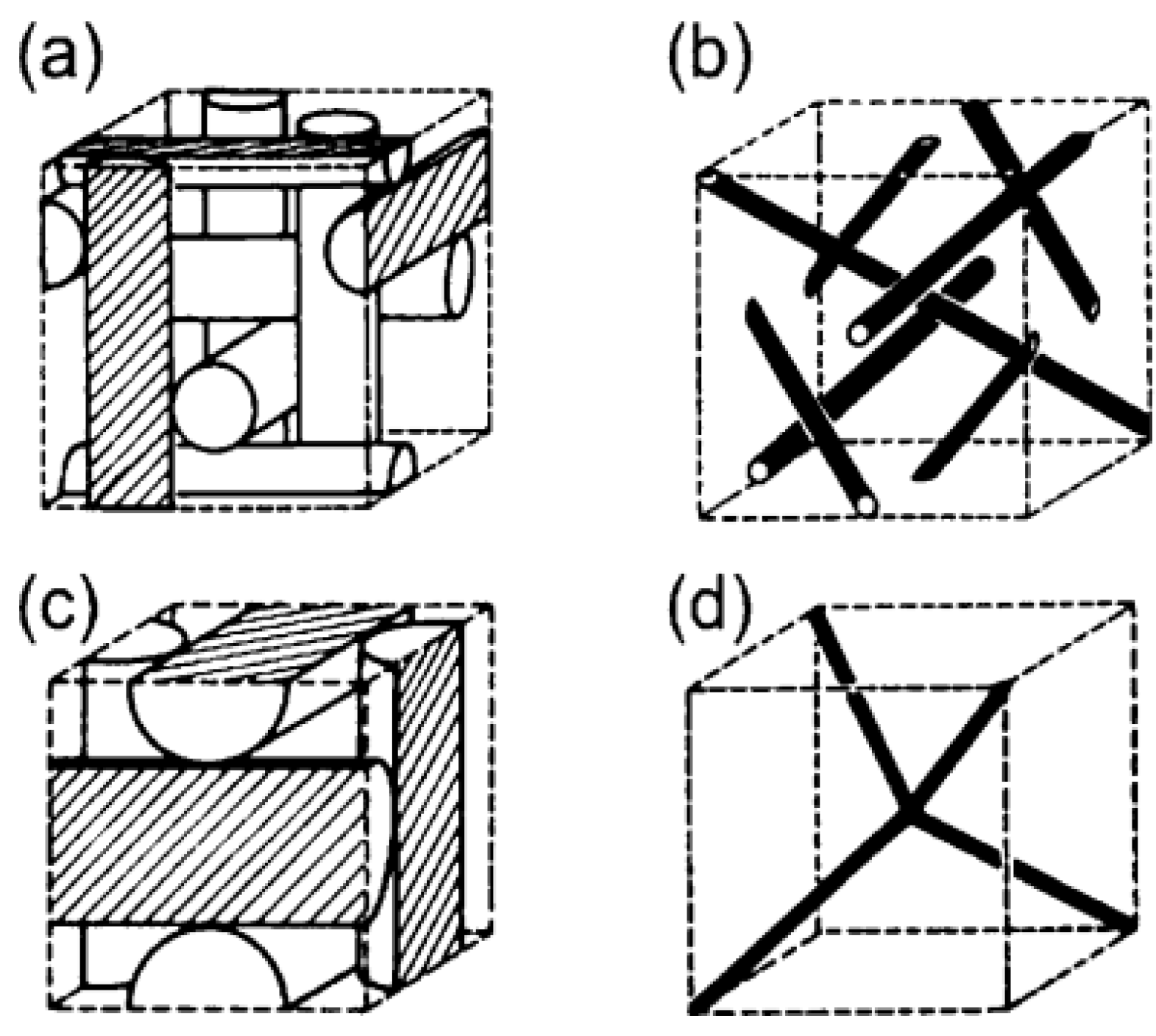
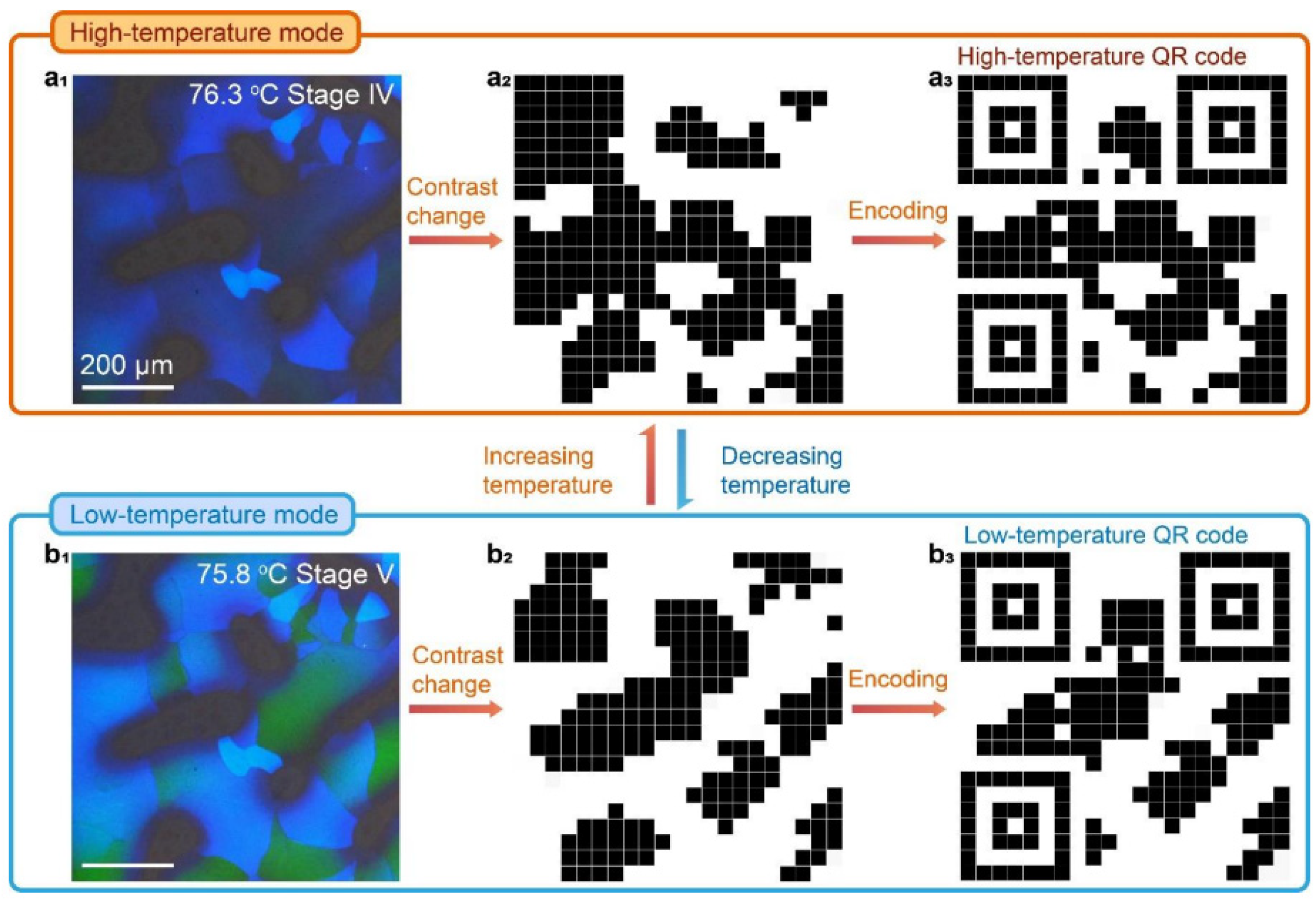


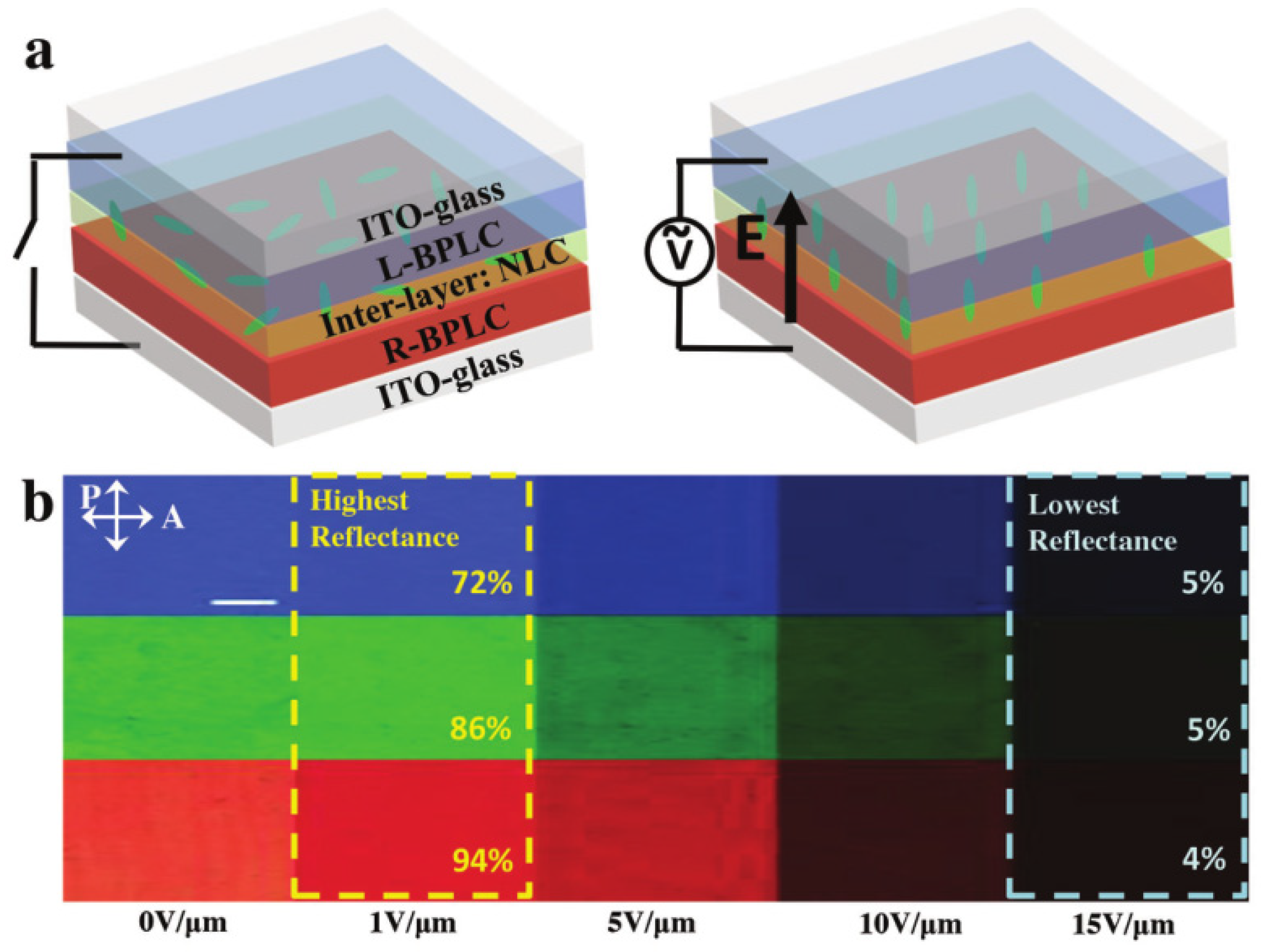


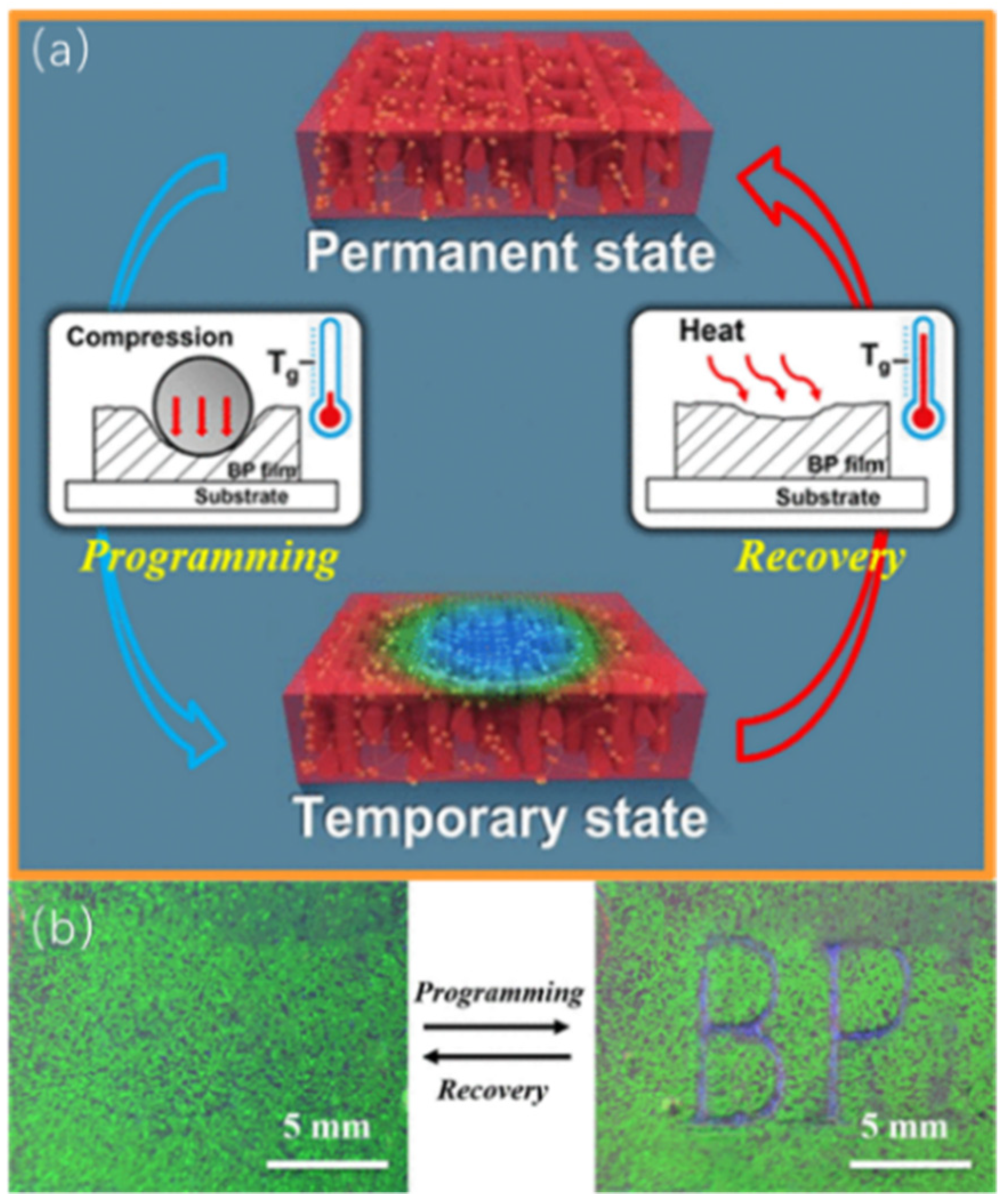

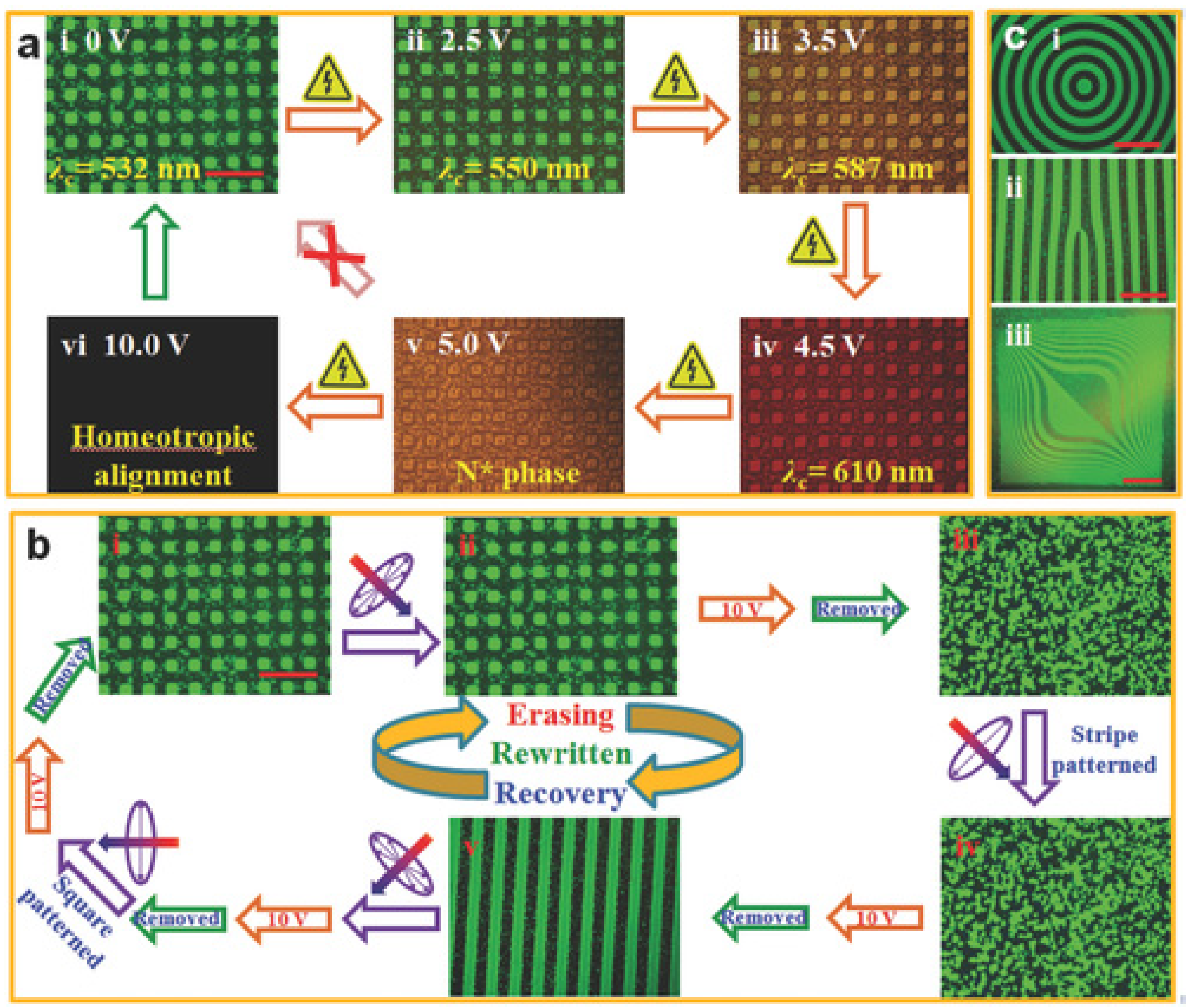
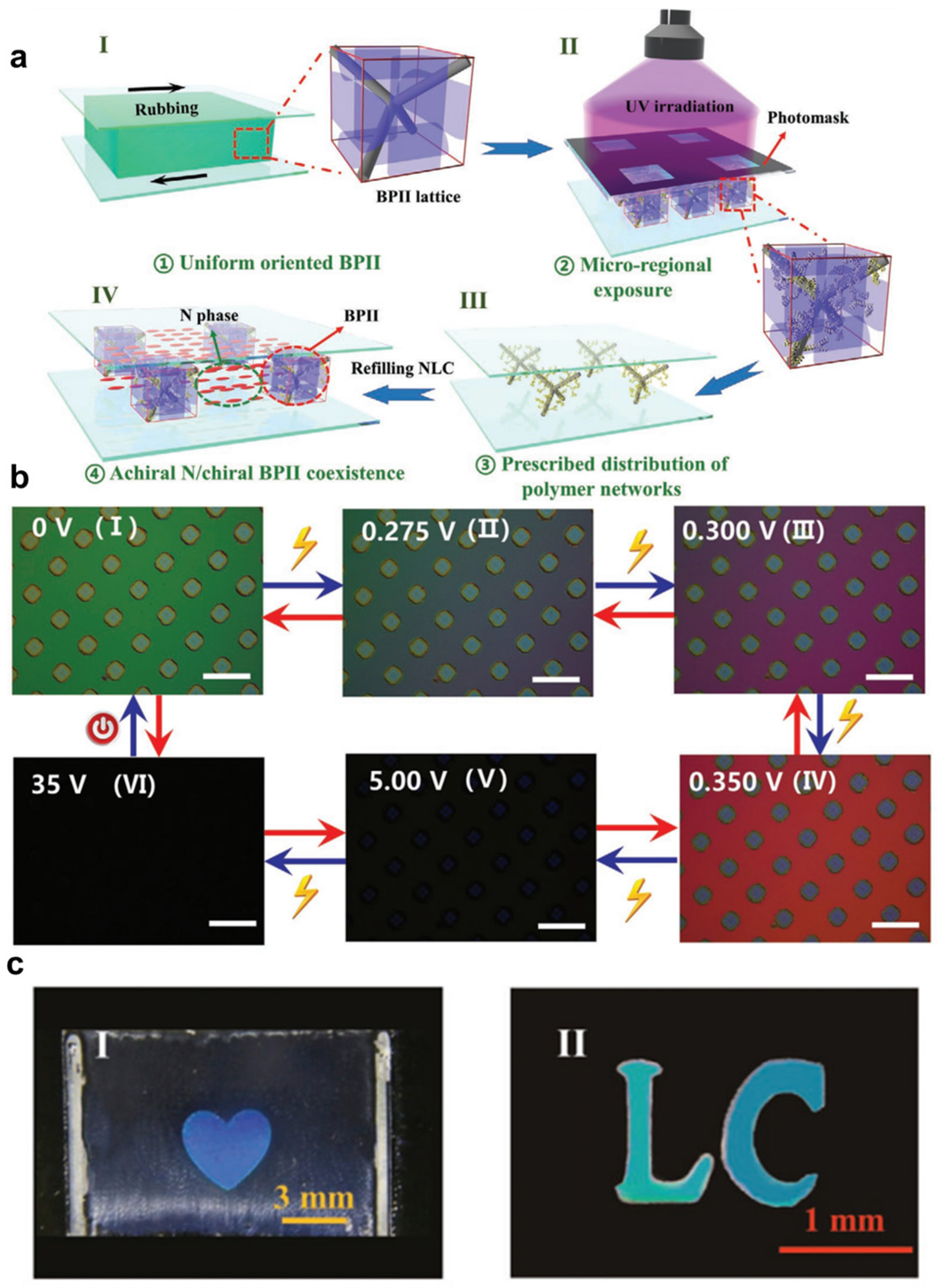
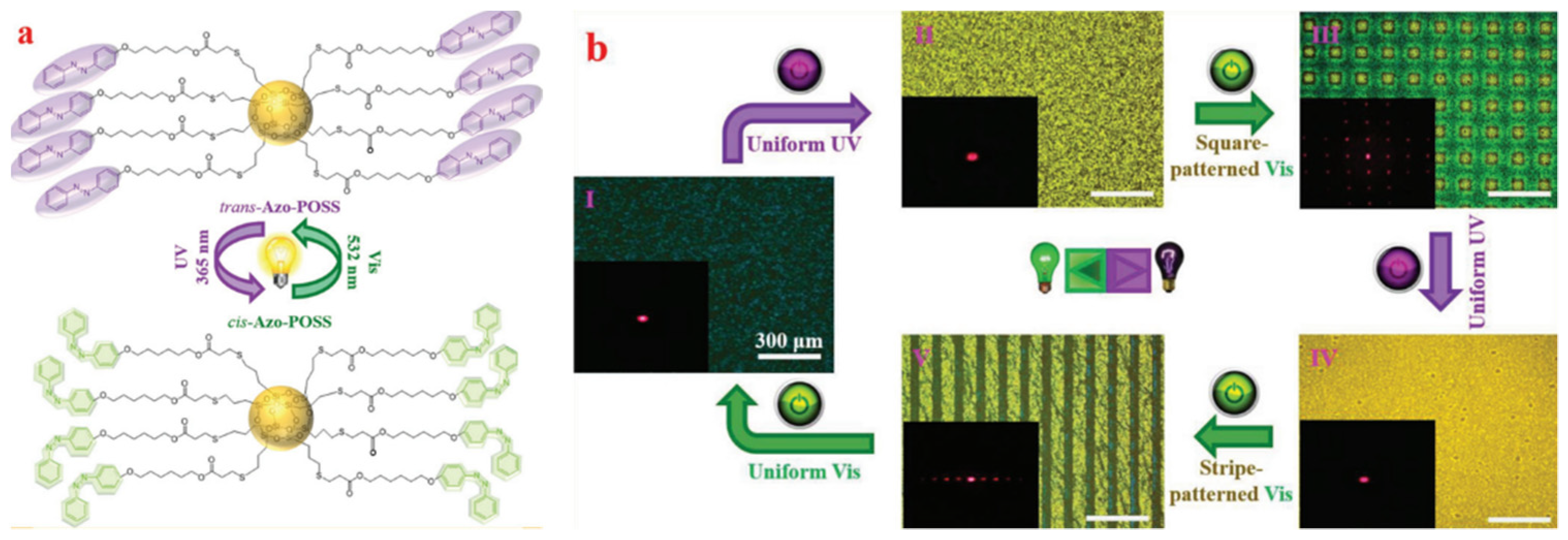


Disclaimer/Publisher’s Note: The statements, opinions and data contained in all publications are solely those of the individual author(s) and contributor(s) and not of MDPI and/or the editor(s). MDPI and/or the editor(s) disclaim responsibility for any injury to people or property resulting from any ideas, methods, instructions or products referred to in the content. |
© 2022 by the authors. Licensee MDPI, Basel, Switzerland. This article is an open access article distributed under the terms and conditions of the Creative Commons Attribution (CC BY) license (https://creativecommons.org/licenses/by/4.0/).
Share and Cite
Wang, H.; Zhou, H.; He, W.; Yang, Z.; Cao, H.; Wang, D.; Li, Y. Research Progress on Blue-Phase Liquid Crystals for Pattern Replication Applications. Materials 2023, 16, 194. https://doi.org/10.3390/ma16010194
Wang H, Zhou H, He W, Yang Z, Cao H, Wang D, Li Y. Research Progress on Blue-Phase Liquid Crystals for Pattern Replication Applications. Materials. 2023; 16(1):194. https://doi.org/10.3390/ma16010194
Chicago/Turabian StyleWang, Hao, Huimin Zhou, Wanli He, Zhou Yang, Hui Cao, Dong Wang, and Yuzhan Li. 2023. "Research Progress on Blue-Phase Liquid Crystals for Pattern Replication Applications" Materials 16, no. 1: 194. https://doi.org/10.3390/ma16010194




